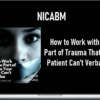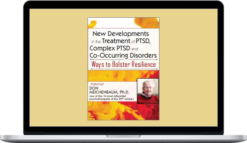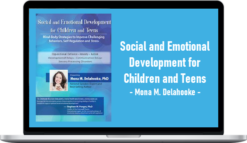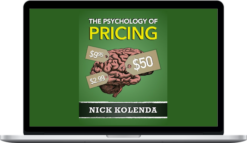NICABM – The Clinical Application of Compassion
$397.00 $57.00
Total Sold: 1
»Instant Delivery
Description
NICABM – The Clinical Application of Compassion
Description of The Clinical Application of Compassion
What do we do when our go-to strategies – the strategies we rely on most to work with depression, anxiety, shame, fear, anger, and especially trauma – don’t work as well as we’d like them to?
What if there was one key element that could open up those places where we so often get stuck – even with our most challenging clients?
I’m talking about compassion.
You see, the way we now understand how compassion affects the brain and body can be game-changing for helping clients heal. Not only that, it’s constantly evolving.
Promising clinical research into the healing power of compassion can take our treatment strategies in a new direction.
This can improve our work with so many clients, especially when we start seeing a client’s progress stall, and we begin feeling like our tried-and-true interventions just aren’t working.
You see, we now have research into compassion that simply didn’t exist, even just a short time ago.
Looking back, there were probably a lot of things about compassion that seemed intuitive to us, but we had no science to back them up.
Now we have that science.
Researchers studying compassion can now identify what actually happens in the brain and in the nervous system when people practice compassion.
Not only that, we also understand compassion’s impact on the treatment of trauma much better than we did even five years ago.
And finally, we’ve learned more ways to work with the healing power of compassion. Ways to apply it that can help people who are struggling with anxiety and depression.
Compassion-oriented therapy is opening up new opportunities for practitioners to be even more effective with their patients.
But integrating compassion into your work can be complicated and nuanced.
That’s why we developed an advanced program that gathers all the latest on compassion and how we can apply it to our work . . .
. . . and we’re calling all practitioners, all over the world, to join us for the next four weeks as we meet to focus on the clinical application of compassion.
What you’ll learn in The Clinical Application of Compassion:
The Neurobiology of Compassion

Paul Gilbert, PhD Kristin Neff, PhD Jack Kornfield, PhD
Kelly McGonigal, PhD Christopher Germer, PhD
Dennis Tirch, PhD Emiliana Simon-Thomas, PhD
- How Compassion Blocks Fear and Activates Courage in the Brain
- How the Brain Processes Threat and Compassion’s Specific Role in Dialing It Down
- One Part of the Brain That Can Block Compassion – and What We Can Do About It
- The Surprising Role of Reward and Pleasure in the Context of Suffering
- How Compassion Improves Heart Rate Variability and Vagal Tone
- How to Apply the 3 Circles Model of Emotions to Help Clients Heal from Shame
How Compassion-Oriented Therapies Work and What Makes Them So Effective

Christopher Germer, PhD Dennis Tirch, PhD
Geshe Lobsang Tenzin Negi, PhD Paul Gilbert, PhD
Kristin Neff, PhD Jack Kornfield, PhD
Christopher Willard, PsyD
- The “Unholy Trinity” that Blocks Compassion and Keeps Clients Locked in Harsh Blame and Judgment (and How to Work with It)
- Why Self-Compassion Is an Intelligent Response to Emotional Pain
- Old Brain, New Brain – How to Help Clients Cope with Today’s Stress by Managing Yesterday’s Brain Processes
- The Self-Compassion Break – A Simple Yet Powerful Practice to Help Clients Cultivate Compassion and Manage Painful Emotions
- How Fight, Flight, and Freeze Protect Us from Danger, But Backfire During Emotional Distress
- 6 Key Compassion Exercises to Boost Your Client’s Capacity to Weather Distress and Transform Suffering
How to Transform Shame with Self-Compassion

Deborah Lee, DClinPsy Christopher Germer, PhD
Kristin Neff, PhD Paul Gilbert, PhD Jack Kornfield, PhD
Dennis Tirch, PhD Susan Pollak, MTS, EdD
Laura Silberstein-Tirch, PsyD Christopher Willard, PsyD
- The Power of Self-Compassion to Neutralize Self-Criticism and Reduce Shame (and the Science Behind It)
- How to Help Clients Develop Compassion Motivation (and Why It’s Key for Healing Shame)
- How to Help Clients Break Free from the Vicious “Shame-Maintenance Cycle”
- 3 Paradoxes of Shame (and Their Surprising Parallels with the 3 Key Components of Self-Compassion)
- Using Imagery and Visualization to Help Your Client Shift out of Shame
- A Step-by-Step Guide to Helping Clients Create a Corrective Emotional Experience
How to Skillfully Apply Compassion in the Treatment of Trauma and Attachment Ruptures

Kristin Neff, PhD Deborah Lee, DClinPsy
Jack Kornfield, PhD Dennis Tirch, PhD
Christopher Germer, PhD Christopher Willard, PsyD
Susan Pollak, MTS, EdD Laura Silberstein-Tirch, PsyD
- Why Compassion Is So Effective for Helping Clients Process Trauma
- Using Compassionate Imagery to Help Traumatized Clients Increase Their Window of Tolerance
- How to Integrate Self-Compassion into 3 Specific Phases of Trauma Treatment
- How to Help Clients Identify Their Emotional Triggers and Go-To Safety Behaviors
- How to Work with “Backdraft” and Other Difficulties that Could Arise for Traumatized Clients in Compassion-Oriented Treatment
- Navigating a Client’s Fears, Resistance, and Blocks to Compassion in the Treatment of Trauma
More courses from the same author: NICABM
Delivery Policy
When will I receive my course?
You will receive a link to download your course immediately or within 1 to 21 days. It depends on the product you buy, so please read the short description of the product carefully before making a purchase.
How is my course delivered?
We share courses through Google Drive, so once your order is complete, you'll receive an invitation to view the course in your email.
To avoid any delay in delivery, please provide a Google mail and enter your email address correctly in the Checkout Page.
In case you submit a wrong email address, please contact us to resend the course to the correct email.
How do I check status of my order?
Please log in to HealingCourse account then go to Order Page. You will find all your orders includes number, date, status and total price.
If the status is Processing: Your course is being uploaded. Please be patient and wait for us to complete your order. If your order has multiple courses and one of them has not been updated with the download link, the status of the order is also Processing.
If the status is Completed: Your course is ready for immediate download. Click "VIEW" to view details and download the course.
Where can I find my course?
Once your order is complete, a link to download the course will automatically be sent to your email.
You can also get the download link by logging into your HealingCourse account then going to Downloads Page.
Related products
Total sold: 7
Total sold: 1









